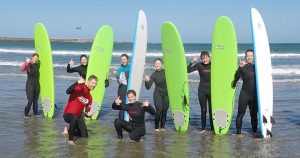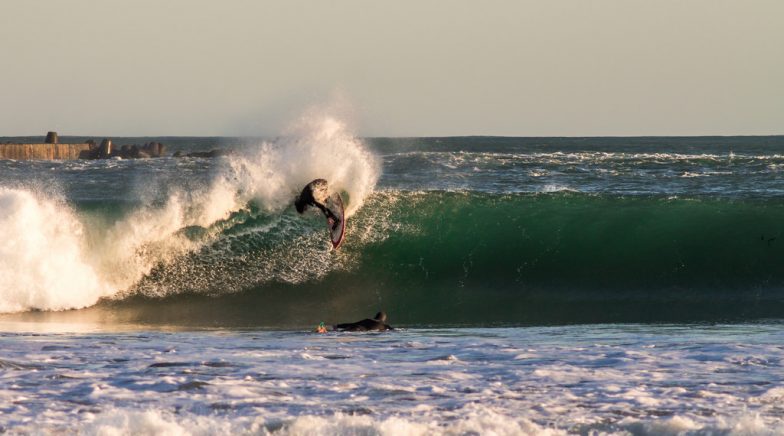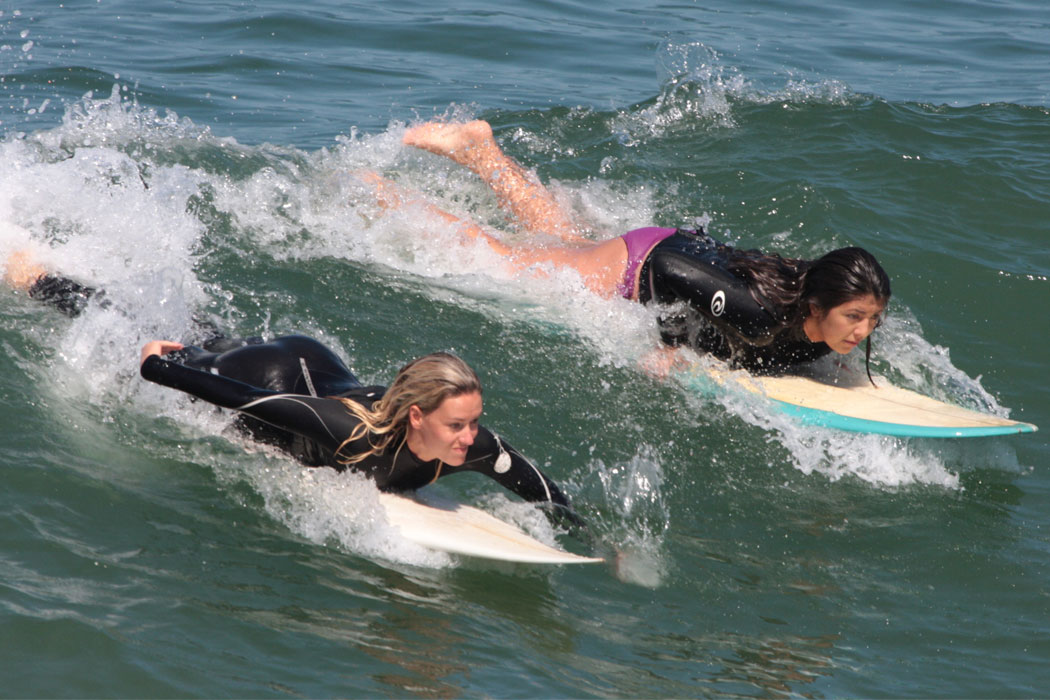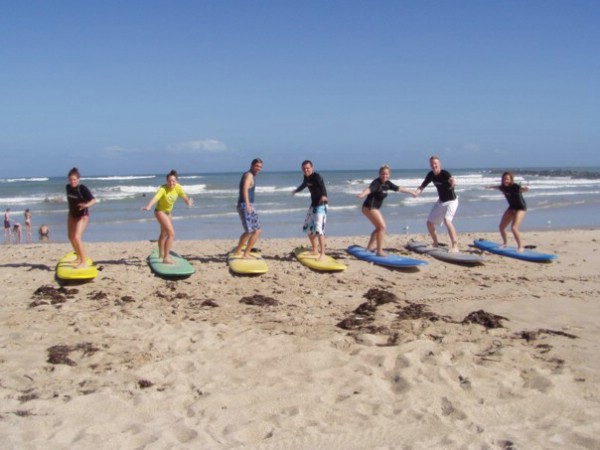Lyall Bay Surf Lessons

Wellington Surf Lessons is located at Lyall Bay Beach and we provide all the equipment you need for an awesome surf experience.
To book contact us at [email protected]


Wellington Surf Lessons is located at Lyall Bay Beach and we provide all the equipment you need for an awesome surf experience.
To book contact us at [email protected]

We recommend to begin with, rather than paddling straight out the back into the line up, it’s best to catch a few broken whitewater waves in shallower water. You should have your ideal trim/paddling position at this stage, so have your board pointing directly towards the beach and as the whitewater approaches paddle towards shore. The wave should pick you up and push you forward which is an unmistakable feeling, however if your board pearls or nosedives you have set off positioned too far forward on the board, likewise if the wave passes under you are positioned too far back on the board.
It’s fun to catch and ride a few to the beach whilst still laying down to get the feeling of the wave, after that it’s time to stand up which we will go onto in the next section. Once you have the hang of catching white water it’s time to use those paddling skills and get out into the lineup to catch the unbroken waves which is what surfing is all about. Once in the lineup, past where the waves are breaking, sit up and straddle your board (you might want to practice the art of sitting on your board as it takes a little time to find your balance). Always face out to sea until you are ready to catch a wave. Practice swinging the nose of the board left or right so that you can easily turn around to catch an oncoming wave. Pick a wave that has not broken and be sure to sit far enough out among the sloping swells, not where the waves are standing up straight.
As a wave approaches, turn the nose of your board toward the beach, lay down and begin paddling. As you feel the wave lift you and your board, paddle as hard as you can and lean your weight forward. The natural tendency is to lean back to keep the nose from going under water, but that will only slow your momentum which in not conducive to wave-catching.
Lean forward but raise your chest so that your weight is just above the centre of the board. You should now be sliding down into the trough of the wave. The first phase of surfing will entail that you wait until you are in the flat water in front of the wave before you stand up. However, the ideal is to begin standing just as you feel the pull of the wave. Now you are ready to work on standing.
If you would like to speed up the process of learning to surf we offer a full range of lessons at Wellington Surf Lessons from beginner to advance
www.wellingtonsurflessons.co.nz

If you are new to surfing, have no worries! We offer a range of courses right from introductory courses to learn about safety of surfing to general riding lessons which help you learn basic skills and get initiated to the sports. Our advanced courses are for the students to learn new tricks and amp up their game.

Standing up on a surfboard can look very easy but once you place that surfboard on a moving, pitching, surge of swirling water where you must simultaneously leap from a prone position while weighting and unweighting left, right, front, and back just to keep from diving face forward, you’ll soon realise a lot of practice will be needed! The place to start to stand is on the beach. Firstly you will need to know which foot will feel most natural to you in the forward position. The left foot forward is called natural stance and the right foot forward is a goofy foot stance. The way to find out which way you swing (!) is to stand up straight, close your eyes and ask a friend to gently nudge you forward, the foot that goes out first to steady yourself is your leading foot!
The motion from prone to standing is called the pop-up, which is basically a quick push up to your feet. Lie the board on the sand (watch the fins) and do a push-up, once your arms are at full extension, pull both knees toward your stomach and hop to your feet. If you practice this regularly it will help when in the water.
The next step is to get out there and do it. It will be best to start in the whitewater:
Step 1—Paddle for a wave and just as you feel the momentum of the surfboard flow faster than your paddling speed, you are ready to hop up.
Step 2—With your hands firmly grasping each rail push up quickly.
Step 3—Simultaneously, extend your arms completely and pull your knees quickly up to your chest. Be sure to keep your weight centred with just a little slant forward.
Step 4—Place your feet firmly on your board, one foot near the tail and one foot just above the midpoint of the board.
Step 5—Don’t stand up completely erect. Keep a low centre of gravity by crouching down and focusing your weight on the midpoint of the board. Keep your arms out, your eyes looking forward and balance.
Surfing is a blast most times, however we often are quick to dismiss the danger involved – most likely because its so addictive, so we tend to not care. Every year surfers lose their lives, and while this is sometimes inevitable, understanding the waves, weather conditions, and your own fitness and ability levels can make all the difference to your safety. So before you paddle out, here are a few things to keep in mind to ensure your survival.
Maintain Your Surfing Fitness
If you’re like most surfers, just paddling out a few times a week will keep you fit enough, or so you think. Going one step further and training while not in the water will not only improve your surfing, but help you keep calm in dangerous situations
Always stretch before you head out so your muscles can warm up and if you’re doing regular fitness training, an all-round workout including cardiovascular, weights, balance training and stretching, this will give you the best endurance in the water.
Cardiovascular training and fitness are what you should be focusing on when not in the water.
Know The Area
Each break is different and knowing what to expect before you paddle out is going to give you a huge advantage.
If you’re new to the area, ask other surfers what the conditions are like. Are there rocks or a shallow reef lurking below that aren’t visible from the surface? Are there strong rips that will funnel you out to sea? Know the tides and how this affects the breaks (and your ability to get back to shore).
Whats normal ocean activity at your home break WILL NOT be the same when surfing overseas. If you’ve ever been surfing in Indonesia when the surf transforms from a leisurely 3ft to a thick 8-10ft reef draining slab within 20 minutes, you’ll realize the importance of this point.
Before you jump in:
Look at other surfers in the line-up to check if they are drifting, which way and how fast.
Watch for where the waves are breaking most consistently, and where they are closing out.
Count the number of waves in each set, and the time in between sets. This tip alone could save you LOTS of energy.
Study The Weather
Take the time to understand the weather and how this affects not only the ocean but your ability to enjoy it. Even slight changes in wind and tides can transform surfable breaks into a torturous mess, and drifting currents can drag you halfway down the coast before you know it.
Always keep an eye on the sky and if you see threatening weather moving in, consider getting out of the water. Remember that the ocean is a wildly powerful force that can unleash its full potential at any time.